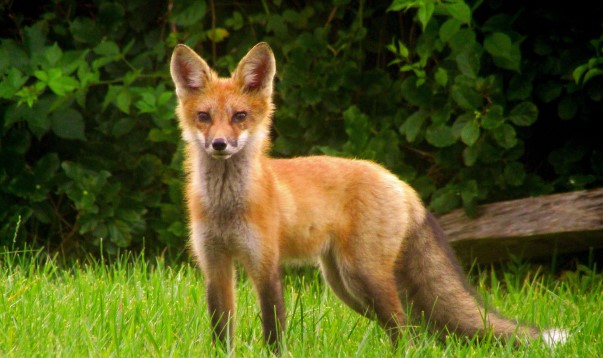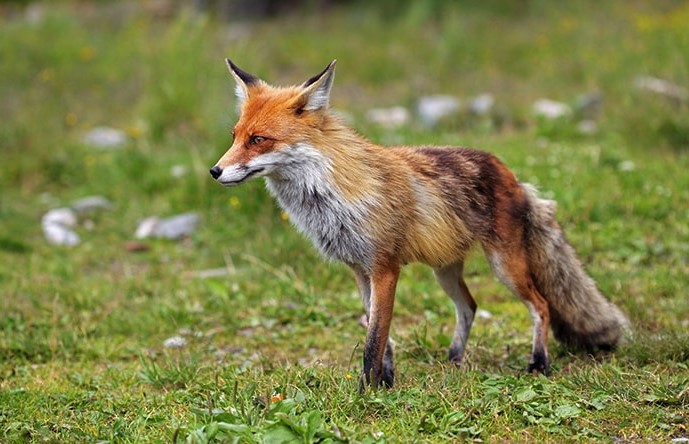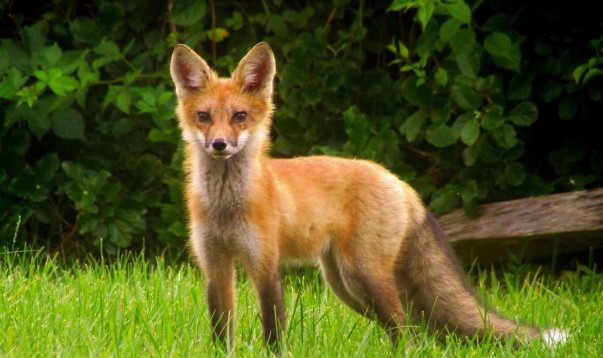
Red Fox: (Vulpes vulpes)
The red fox (vulpes vulpes) is a member of the canidae family, being the largest of the genus vulpes species. They average in size between 14 to 20 inches high, its body ranges from 18 to 32 inches long, its tail is between 13 to 21 inches long, their ears are 3 to 5 inches long and its hind feet are between 5 to 7 inches and weigh between 5 to 31 pounds.
Red foxes have short sparser and coarse fur in the southern regions and fluffier, longer denser fur in the northern regions. Their fur color patterns consist of a bright reddish orange with yellowish tints. Along its spine are brown – reddish chestnut colored fur. Its lower back is a silvery color, its belly and under – parts consist of black, dark brown or red. Its chin, lower lips, throat and chest are white. Its tail is bushy, that is a bright reddish orange with yellowish tints and has black at the top, along the edges and bottom tip. Their faces resemble a dog, but they have a longer muzzle. Red foxes are found throughout the world, including Florida. Originally they were only found in the panhandle of Florida but now they can be found throughout the state. They normally inhibit uplands, such as fields and weedy pastures; avoiding heavily wooded areas unlike the gray fox. Red foxes adapt well to other environments including farms, residential areas and large communities.
Red foxes are mainly solitary hunters; that hunt at night as they are nocturnal. They are omnivores meaning they consume both plant and animal materials, primary feeding on birds, rabbits, rodents, fish, frogs and
carrion (dead animals). They also consume fruits and vegetables.
Red foxes are mainly nocturnal, but they are also known to be crepuscular (out during the day feeding). In the wild red foxes have an average life span of 3 years due to their natural predators. They are solitary animals and never form packs, however they do tend to stay with family groups consisting of 1 male, 1 or 2 females and their young. Their territorial ranges vary in sizes depending on the environment they are inhibiting. Territories that have an abundance of food sources are smaller, ranging between 5 to 12 square kilometers, those that have a weak food supply are larger, ranging between 20 to 50 square kilometers. Red foxes are territorial and will defend its home when needed, although sometimes their territories may over – lap each other. Red foxes create dens in dense vegetation with pathways leading to other resting sites, hunting areas, food storage and the main den, these dens usually have several emergency burrows. Their dens are usually 20 to 40 feet long and 3 to 4 feet deep. They also use dens from other animals such as rabbits. They dig larger dens and use them during the winter or when they are giving birth and raising their young. Many generations will often return to use this same den. Red foxes can leap as high as 2m and reach speeds of 48 km/h. They communicate using a variety of vocals, face expressions and extensively scent markings. They have 28 different vocal sounds and use their urine, feces, anal sac secretions, the supracaudal gland and its glands around its lips, jaws and the pads of its feet for scent. Red foxes have a remarkable senses of smell, vision and touch. Red foxes can breed as early as 10 months old, depending on their first heat cycle, which is in the late fall or early winter. Red foxes usually mate once and then remain with their partner for life, although on rare occasions the male may have a few female partners. Its gestation period lasts approximately 53 days. The average litter size is 1 to 5 pups. When the pups are born their eyes are closed leaving them blind for about 9 to 14 days. When the pups are around 4 to 5 weeks old they begin leaving the den. The mother has the pups completely weaned by the time they are 8 to 10 weeks old. The pups will stay with their mother until autumn.
Red foxes are known to carry diseases such as distemper, parvo – virus, and rabies. The parasites include heart – worms, lung – worms, tape – worms and round – worms which lowers their resistance to be able to fight off other infectious diseases. They are also know to carry echinococcosis tapeworm, which can be transmitted to humans causing a serious, and sometimes fatal disease in humans.
Red foxes cause serious damage to livestock, such as turkey, chicken, geese, ducks, pigs and lambs. These losses can be devastating to the farmers. They can also kill small pets.

